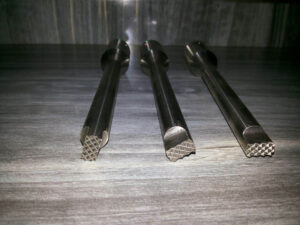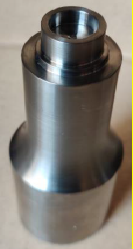An ultrasonic horn (also known as acoustic horn, sonotrode, acoustic waveguide, ultrasonic probe) is a tapering metal bar commonly used for augmenting the oscillation displacement amplitude provided by an ultrasonic transducer operating at the low end of the ultrasonic frequency spectrum (commonly between 15 and 100 kHz). The device is necessary because the amplitudes provided by the transducers themselves are insufficient for most practical applications of power ultrasound. Another function of the ultrasonic horn is to efficiently transfer the acoustic energy from the ultrasonic transducer into the treated media, which may be solid (for example, in ultrasonic welding, ultrasonic cutting or ultrasonic soldering) or liquid (for example, in ultrasonic homogenization, sonochemistry, milling, emulsification, spraying or cell disruption). Ultrasonic processing of liquids relies of intense shear forces and extreme local conditions (temperatures up to 5000 K and pressures up to 1000 atm) generated by acoustic cavitation.
The ultrasonic horn is commonly a solid metal rod with a round transverse cross-section and a variable-shape longitudinal cross-section – the rod horn. Another group includes the block horn, which has a large rectangular transverse cross-section and a variable-shape longitudinal cross-section, and more complex composite horns. The devices from this group are used with solid treated media. The length of the device must be such that there is mechanical resonance at the desired ultrasonic frequency of operation – one or multiple half wavelengths of ultrasound in the horn material, with sound speed dependence on the horn’s cross-section taken into account. In a common assembly, the ultrasonic horn is rigidly connected to the ultrasonic transducer using a threaded stud.
Ultrasonic horns may be classified by the following main features: 1) Longitudinal cross-section shape – stepped, exponential, conical, catenoidal, etc. 2) Transverse cross-section shape – round, rectangular, etc. 3) Number of elements with different longitudinal cross-section profile – common and composite. A composite ultrasonic horn has a transitional section with a certain longitudinal cross-section shape (non-cylindrical), positioned between cylindrical sections.




